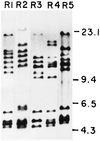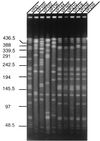Clonal diversity among recently emerged strains of Vibrio parahaemolyticus O3:K6 associated with pandemic spread
- PMID: 10364615
- PMCID: PMC85163
- DOI: 10.1128/JCM.37.7.2354-2357.1999
Clonal diversity among recently emerged strains of Vibrio parahaemolyticus O3:K6 associated with pandemic spread
Abstract
The genomes of the O3:K6 strains of Vibrio parahaemolyticus which abruptly emerged in Calcutta, India, in February 1996 and which demonstrated an unusual potential to spread and an enhanced propensity to cause infections were examined by different molecular techniques to determine clonality. No restriction fragment length polymorphism (RFLP) in the gene encoding the thermostable direct hemolysin was observed among the O3:K6 isolates of V. parahaemolyticus. Clonal diversity among the O3:K6 strains became evident by examining the RFLPs of the rrn operons and by the use of pulsed-field gel electrophoresis. Five ribotypes were distinguished among the O3:K6 strains examined, with ribotype R4 constituting the major type. Strains of O3:K6 isolated between June and August 1996 showed different pulsotypes compared to the pulsotypes of strains isolated before and after this period, indicating genetic reassortment among these strains, but those isolated between August 1996 and March 1998 showed identical or nearly similar pulsotypes. It is clear that there is a certain degree of genomic reassortment among the O3:K6 clones but that these strains are predominantly one clone.
Figures



References
-
- Bhadra R K, Roychoudhury S, Banerjee R K, Kar S, Majumdar R, Sengupta S, Chatterjee S, Khetawat G, Das J. Cholera toxin (CTX) genetic element in Vibrio cholerae O139. Microbiology. 1995;141:1977–1983. - PubMed
-
- Brosius J, Ullrich A, Raker M A, Gray A, Dull T J, Gutell R R, Noller H F. Construction and fine mapping of recombinant plasmids containing the rrnB ribosomal RNA operon of E. coli. Plasmid. 1981;6:112–118. - PubMed
-
- Centers for Disease Control and Prevention (Atlanta, Ga.). Unpublished data.
-
- Honda S, Goto I, Minematsu I, Ikeda N, Asano N, Ishibashi M, Kinoshita Y, Nishibuchi M, Honda T, Miwatani T. Gastroenteritis due to Kanagawa negative Vibrio parahaemolyticus. Lancet. 1987;i:331–332. - PubMed
Publication types
MeSH terms
Substances
LinkOut - more resources
Full Text Sources

